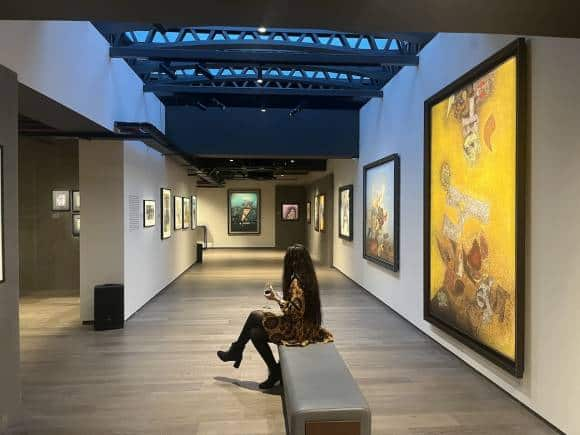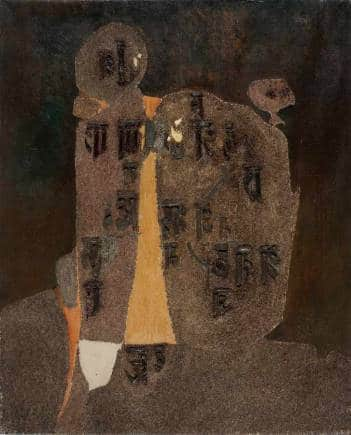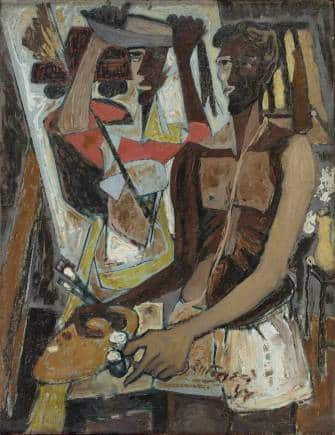



Shanti Dave was a teenager when he opened a shop for signboards in Ahmedabad. It was a newly-independent India and the young Dave was happy to paint billboards to support his widowed mother. It didn't take much time before he realised his long-held desire to become an artist.
One of the first students at the famed Faculty of Fine Arts, MS University of Baroda in 1950 where his teachers turned out to be the iconic artists NS Bendre and KG Subramanyan, Dave felt at home among the fraternity of artists. Soon, billboards and signboards gave way to canvases.
 'Vijay Chakra', part of Shanti Dave's series of watercolours on the 1965 India-Pakistan war (Photo: DAG)
'Vijay Chakra', part of Shanti Dave's series of watercolours on the 1965 India-Pakistan war (Photo: DAG)Armed with an arts degree and later a training in mural painting, Dave would exhibit his works alongside such artists as MF Husain, Bendre and Sankho Chauhuri as a 24-year-old at the first national exhibition of art organised by the Lalit Kala Akademi in 1955, a year after it was set up to promote understanding of Indian art.
A founder-member of the Baroda Group of Artists, Dave joined fellow-members Subramanyam, Bendre, GR Santosh and others in the group's first exhibition held in Baroda in 1956. In the same year, he was invited to paint two murals in the Parliament House. Dave would go on to win prestigious prizes, participate in biennales and shows at home and abroad in the coming decades.
With such a spectacular career, many in the artists' community wonder why Dave isn't mentioned in the same breath as those with whom he worked, exhibited and won honours. A new exhibition of his works, the first-ever retrospective of the artist, hopes to make amends.
Shanti Dave: Neither Earth Nor Sky, which opened at the DAG gallery in New Delhi on July 15, has over 80 works of one of the country's earliest abstractionist painter. Curated by Jesal Thacker, the works on display capture the artist’s journey from figuration to abstraction, including larger-than-life abstract painting, a style that matured over several decades, alongside a range of archival material on the artist.
 The Shanti Dave retrospective has over 80 works of the country's first major abstractionist (Photo: Faizal Khan)
The Shanti Dave retrospective has over 80 works of the country's first major abstractionist (Photo: Faizal Khan)"I had stopped painting eight years ago," says Dave, who was present at a preview of the show on July 14 attended by artists, gallerists and collectors. "A retrospective of my works is a liberating experience," he adds.
Among the works of the retrospective is a sketch he painted for a mural in Air India's New York office, titled Little Gujarat, his series on the 1965 India-Pakistan war, and his encaustic works from the '60s and '70s. All in watercolours, Dave's India-Pakistan war series are considered his only political body of works in his entire career. Words like goli (bullet), hoshiyar (caution), hamla (assault) and chetavani (warning) appear as texts in the watercolours, exhibiting anxiety and care.
The texts in Dave's war series, which has stencils of government posters of dos and don'ts for the public, is readable unlike his other abstract works that uses meaningless letters from the Devanagari script.
"Dave was more or less forgotten in the past few decades. He was not seen as part of the mainstream," says poet Ashok Vajpeyi. "He had emerged as an important painter in the '60s and '70s. His body of work reveals how wide a range he has," adds Vajepeyi, the managing trustee of the Raza Foundation. "He was the first artist who introduced letters from the Devanagari script in paintings. He was not burdened by their meaning, but did a kind of primordial, pre-linguistic construction of letters."
 'What I Crave', an encaustic and gravel on canvas by Shanti Dave from 1966.(Photo: DAG)
'What I Crave', an encaustic and gravel on canvas by Shanti Dave from 1966.(Photo: DAG)Born in 1931 in Badapura village in Anand district of Gujarat, Dave married at the age of 18 while he was painting signboards in Ahmedabad. His curious mind wandered easily into the fine arts classrooms in Baroda, helping him learn the finer aspects of art. Dave, who began his artistic career as an abstractionist, worked with a variety of material like enamel, sand, gravel and Plaster of Paris, some of which for the first time by an artist in the country.
His early figurative works were influenced by his teacher and mentor Bendre. As a leading member of the Baroda Group of Artists, Dave held solo exhibitions in Baroda and at the Jehangir Art Gallery, Mumbai in the late '50s before making Delhi his home in 1960. He had more solo shows in the next few years, in Rome and Frankfurt, and received commissions from Air India to paint murals in their offices in Mumbai, Delhi, Frankfurt, New York and Rome.
"Always drawn towards abstraction, I remained aware of Shanti bhai’s work and was fortunate enough to start building a modest collection of important paintings from an early stage onwards and included them in exhibitions at our galleries in India as well as in New York, besides showing his work at art fairs," says DAG's CEO and MD, Ashish Anand.
 'Untitled (Self-Portrait)', an oil on masonite board by Shanti Dave from 1954. (Photo: DAG)
'Untitled (Self-Portrait)', an oil on masonite board by Shanti Dave from 1954. (Photo: DAG)"But it was only a few years back that I was able to acquire a sizeable part of his estate to justify an exhibition such as this—the first-ever retrospective on the artist," adds Anand. "Why it has taken so long—and so late in his career—to have an exhibition such as this is, however, inexplicable. For me, his style and technique are unparalleled. He was India’s first major abstractionist to incorporate beeswax into his practice and his encaustic paintings often appear like sculptures in relief. The indecipherable scripts in his paintings appear to me like history having a conversation with itself."
A gold medal winner at the third and fourth editions of the Triennale India in 1975 and 1977, Dave participated in a group exhibition with artists like Husain, Krishen Khanna, J Swaminathan, Ram Kumar and Satish Gujral in Delhi in 1977 for a charity on the specially abled. A recipient of the Padma Shri award in 1985, he suffered a heart attack in 1990 hampering continuous work. Dave's last major show was at the Jaipur Art Summit in 2014.
The retrospective will run up to September 10.Discover the latest Business News, Sensex, and Nifty updates. Obtain Personal Finance insights, tax queries, and expert opinions on Moneycontrol or download the Moneycontrol App to stay updated!
Find the best of Al News in one place, specially curated for you every weekend.
Stay on top of the latest tech trends and biggest startup news.